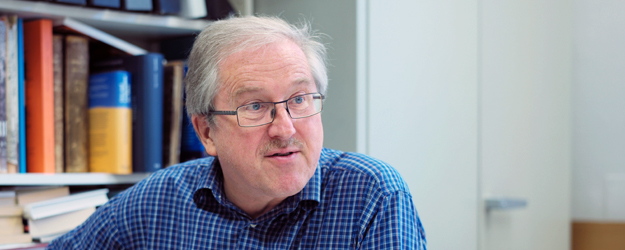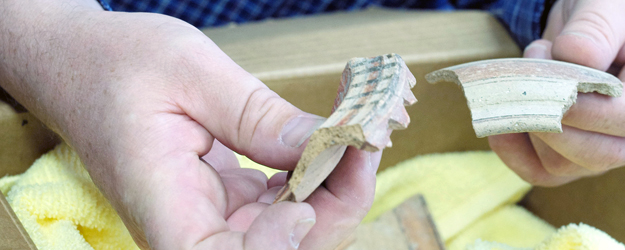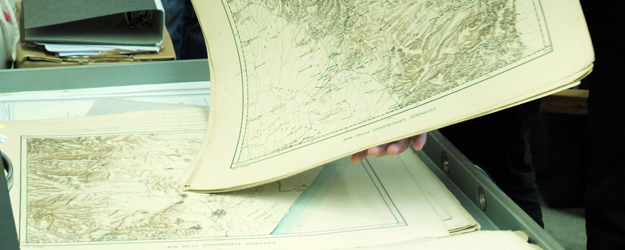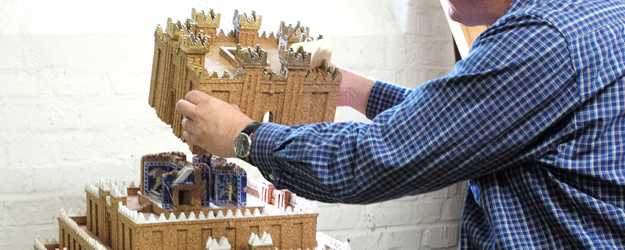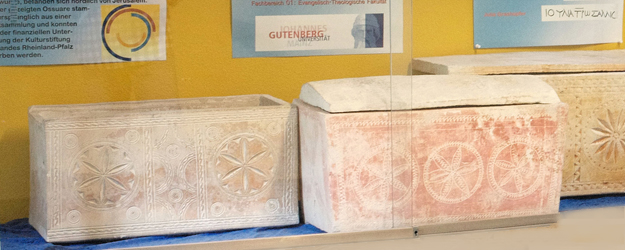10 November 2014
Hardly any other collection of Johannes Gutenberg University Mainz (JGU) can boast as many unique pieces. Models represent life in Biblical times, ten thousand photos and valuable maps document the early history of Israel while seven ossuaries evidence a turning point in burial practices at the time of Christ. The Biblical Archaeology Collection may be relatively new but it goes way back into ancient history.
Professor Wolfgang Zwickel starts small: "These here are nothing special, not real museum pieces," explains the theologian while opening an inconspicuous cardboard box. He unfolds a towel to reveal the remains of a ceramic cooking pot. "What we find during our digs is 99 percent shards and bones and a mere 1 percent other things. This was not a civilization experiencing a cultural blossoming but a poor country. Those who inhabit the West Bank and Gaza Strip have never been wealthy. It was just as true then as it is now."
Even so, there are still a number of treasures to be admired in the rooms occupied by the JGU Faculty of Protestant Theology. A lot may seem unimpressive at first glance but other pieces are truly striking. The Biblical Archaeology Collection bears witness to the long history of Palestine, of the Holy Land.
Shards, shards, and more shards
"What we have here are the shards of an Edomite pot from the seventh or sixth century B.C.," says Zwickel. "See the ripples, the painting?" He turns the shards in his hands. The collection quite literally provides for hands-on archaeology.
"Ceramics are important to us. They break relatively quickly and they are cheap. They are also common and subject to the whims of fashion. The various ceramic forms make it possible for us to determine if a particular site dates to the Iron Age I or II period. Roman-Byzantine ceramics are completely different from these Edomite pieces. We think all our students should have the opportunity to actually touch and feel shards like these. Looking at illustrations in books is simply not the same thing."
When Zwickel was appointed Professor of Old Testament Studies and Biblical Archaeology in Mainz, he began to build the collection mainly for use in teaching. "We had no money so what you see here are mostly donations." Together with doctoral candidate Ulrich Hofeditz, Zwickel looks after the pieces stored in various locations in the Forum universitatis building at the main entrance to the Gutenberg campus.
Old maps of Palestine
The Mainz collection of ceramics from Palestine is one of the largest in Germany and this is partly attributable to the fact that strict rules and regulations apply to the export of ancient artifacts from Israel. The holdings in Tübingen probably represent the only other collection that can compete with that at Mainz University. Only a fraction of the pieces are on display in the halls of the faculty. "Our display cases are on loan from the Roman Germanic Central Museum Mainz," Zwickel explains. "And we are very happy to have them." On display are oil lamps and amphora shards, a cosmetic pot and the fragment of an animal sculpture. But these are merely one aspect of the collection.
In his office, Zwickel has drawers filled with large-format maps. "These are the oldest cartographic surveys of modern Israel." The professor displays some magnificent sheets dating back to 1880. One shows Jerusalem and its environs. "The maps are incredibly precise. We superimposed them over modern maps using Photoshop and found that they are often accurate right down to the millimeter." The other maps held in the drawers pale in comparison to this "Survey of Western Palestine," although the collection also includes rare and valuable military maps from World War I.
We then ascend to the attic of the old Forum universitatis barracks where the ceramics are stored. "Shards, shards, and more shards," says Zwickel with a smile. There are also rectangular boxes holding plate glass photo slides from the early 20th century. "Some of these have been colored by hand." Zwickel removes a slide. It depicts the Church of the Nativity in Bethlehem at Christmas 1910. The image is incredibly sharp. "We have digitalized 900 of these photographs." Zwickel and Hofeditz have access to approximately 50,000 digitalized photographs of Palestine. They are valuable historical documents waiting for more detailed academic study.
Ossuaries from Jerusalem
We descend from the attic to the cellar, where we enter a small room. Here we find the Tower of Babel. The waist-high model exhibits very finely worked detail. Small figures can be seen walking up the entrance ramp. Every floor can be removed. The sumptuous interior can then be viewed. This is not the only model in the collection. "We are currently storing the Heavenly Jerusalem underneath the tower," says Hofeditz. And there it will have to remain concealed for today as the tower is too heavy to be easily lifted. But there are other models to be admired, such as those of old tombs – and there is also the replica of a boat. There is almost no other place in Germany that has such a wide variety of models depicting life in Biblical times.
Zwickel has saved the most spectacular pieces for last. Seven ossuaries rest behind glass in the entry foyer of the Faculty of Protestant Theology. These chests for holding bones evidence a turning point in burial customs in Palestine. "They only made them in the period 20 B.C. to 70 A.D. and almost the only places they are found are Jerusalem and Jericho."
After the body of the deceased had decomposed, the bones were placed in an ossuary and buried. Anonymous common graves had previously been the norm in Palestine, and this now marked the gradual shift to individual burials.
Traveling exhibitions
Simple patterns decorate the limestone chests. "The red paint is probably symbolic of life and the engraved rosettes symbolize the sun." Some of the ossuaries seem to be incomplete and there are markings to show what the carver had planned. "These are rare," comments Zwickel. "Very few such pieces have ever been found." A few scratched words commemorate the dead. In one occasion there is a name: "Julia Grasshopper," another reads simply "Darling."
"Nine ossuaries have found their way to Germany. Two are in Tübingen, we have seven," says Zwickel with a hint of pride. He has already loaned several items from the Biblical Archaeology Collection to a number of exhibitions. One focusing on the life of women in ancient Palestine is currently traveling through Austria, Hungary, and Poland. Zwickel also presented an exhibition on Biblical Plants in collaboration with the Botanic Garden of Mainz University and the Gems of the Bible exhibition attracted more than 100,000 visitors on its journey through Rhineland-Palatinate.
However, it is uncertain when the next exhibition will be held as time and funding are tight. But there is no doubt that students will be able to continue to enjoy the collection every semester and will actually hold the shards in their hands and learn how to read them.

